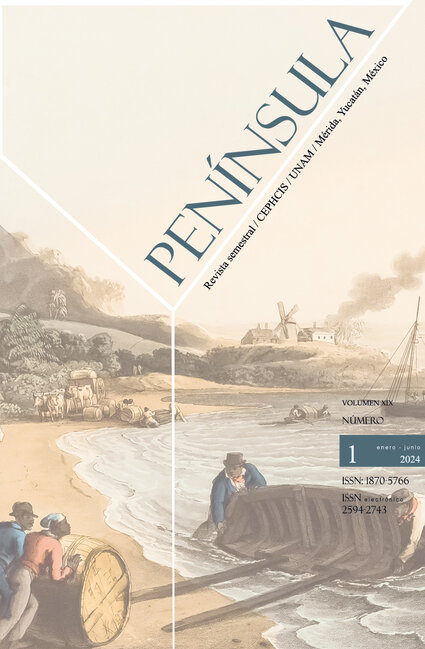An approach to the introduction of slaves to Campeche through Asiento de Negros of England (1713-1739)
Main Article Content
Abstract
These lines address the participation of Campeche in the Asiento de Negros granted to England by Spain from 1713 to 1739. The legal introduction of enslaved people through the port of Campeche had its highest rate during the first half of the 18th century due to the indicated Asiento. Despite the fact that Campeche was not considered among the points for the factories of arrival and sale within the Treaty of 1713. The forest interest and the commercial expansion of the English included the Yucatan territory, and they established a “factory” in Campeche, which they subleased to other settled merchants in Jamaica. Despite the discontent of Spain, the “factory” was made “official” with the nomination of a Spanish authority to supervise it. The consulted historical archives and the previous investigations confirm that during the two decades of that Asiento in Campeche, the legal forced migration amounted to more than 800 enslaved people.
Downloads
Article Details
Citas en Dimensions Service
References
Aguirre Beltrán, Gonzalo. [1946] 1984. La población negra en México. Estudio Etnohistórico. México: sra-Centro de Estudios Históricos del Agrarismo en México.
Banco Nacional de Comercio Exterior. 1967. El contrabando y el comercio exterior en la Nueva España. México: bancomext.
Bolland, Nigel. 1992. Colonialismo y resistencia en Belice. Ensayos de sociología histórica. México: conaculta / Grijalbo.
Borucki, Alex, David Eltis, David Wheat. 2015. “Atlantic History and the Slave Trade to Spanish America”. The American Historical Review 120 (2): 433-461. Consultado el 16 de agosto de 2023. https://academic.oup.com/ahr/article/120/2/433/45569.
Bridges, George W. 1827-1828. Annales of Jamaica, 2 vols. Londres: John Murray, Albermale-Street.
Diccionario de autoridades. 1726-1739. https://apps2.rae.es/DA.html. Consultado el 15 de agosto de 2023.
Donoso, Rafael. 2010. El Asiento de Esclavos con Inglaterra (1713-1750). Sevilla: Universidad de Sevilla.
Donoso, Rafael. 2007. “Un análisis sucinto del Asiento de Esclavos con Inglaterra (1713-1750) y el papel desempeñado por la contabilidad en su desarrollo”. aea 64 (2): 105-144.
Contreras Sánchez, Alicia. 1990. Historia de una tintórea olvidada. El proceso de explotación y circulación del palo de tinte, 1750-1807. Mérida: uady.
García de León, Antonio. 2014. Tierra adentro, mar en fuera. El puerto de Veracruz y su litoral a Sotavento, 1619-1821. México: fce / Universidad Veracruzana.
“John Blackwood, mercante de arte”. 2022. https://hmong.es/wiki/John_Blackwood_(art_dealer. Consultado el 20 de octubre.
Luxán Hernández, Lía de y Santiago de Luxán Meléndez. “Las dificultades de funcionamiento del Asiento de Negros británico en el imperio español, 1713-1739: la misión de Tomás Geraldino en Londres.” Colonial Latin American Historical Review 18, 3 (2013): 273. Consultado el 15 de agosto de 2023. https://digitalrepository.unm.edu/clahr/vol18/iss3/3.
Luxán, Santiago de y Lía Luxán. 2016. “Las Compañías Reales de esclavos y la integración de Cuba en el sistema atlántico del tabaco español, 1696-1739”. Anuario de Estudios Atlánticos, núm. 62: 1-22.
Ngou-Mve, Nicolás. 1994. El África bantú en la colonización de México (1595-1640). Madrid: csic.
O’Malley, Gregory. 2014. Final Passages. The Intercolonial Slave Trade of British America, 1619-1807. Chapel Hill: The University of North Carolina Press.
Patch, Robert. 1991. Maya and Spaniard in Yucatán, 1648-1812. Stanford: Stanford University Press.
Palmer, Colin. 1981. Human Cargoes: The British Slave Trade to Spanish America 1700-1739. Illinois: University of Illinois Press.
Piqueras, José Antonio. 2011. La esclavitud en las Españas. Un lazo trasatlántico. Madrid: Editorial Catarata.
Restall, Mathew. 2009. The Black Middle: Africans Mayas, Mayas and Spaniards in Colonial Yucatan. Stanford: Stanford University Press.
Sorsby, Victoria. 1975. “British Trade with Spanish America under the Asiento”. Tesis de Filosofía. University of London.
Trans-Atlantic Slave Database. 2023. Consultado el 15 de agosto. http:// www.slavevoyages.org.
Valencia Suárez, María Fernanda. 2021. Ingleses furtivos en Mérida, 1765. Construcción y reproducción de visiones inglesas sobre Yucatán. Mérida: unam.
Victoria Ojeda, Jorge. 2015. Corrupción y contrabando en la Península de Yucatán. De la Colonia a la Independencia. Mérida: sedeculta.
Zabala, Pilar, “La presencia africana en Yucatán. Siglos xvi y xvii”. En Orígenes de la sociedad campechana. Vida y muerte en la ciudad de Campeche durante los siglos xvi y xvii, edición de Vera Tiesler y Pilar Zabala, 195-224. Mérida: uady.


